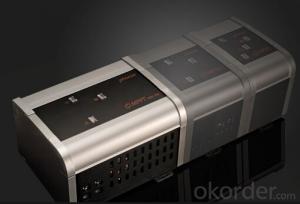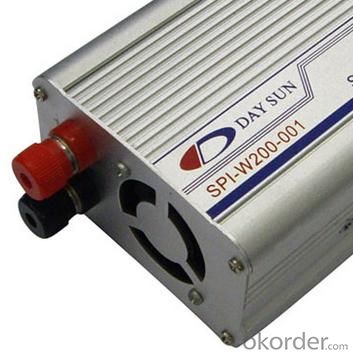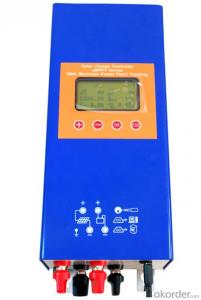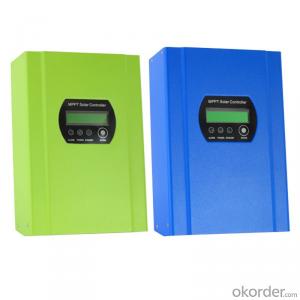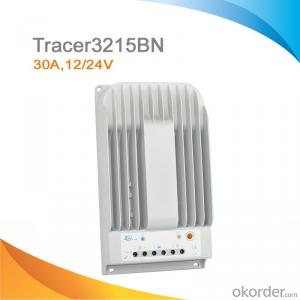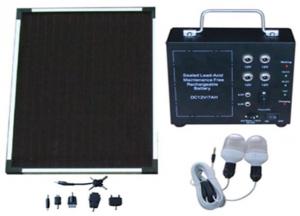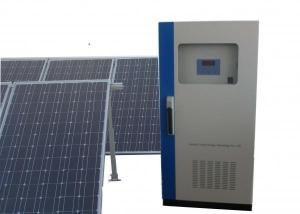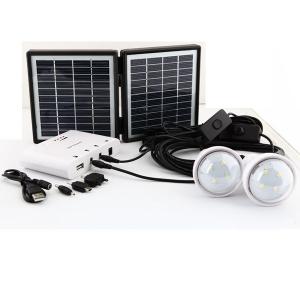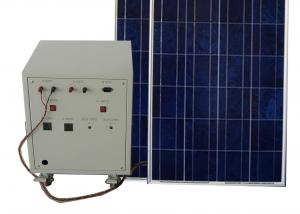Passive and Active Solar Energy Systems Solar MPPT 100/30 (30 A) Maximum Power Point Tracker
- Loading Port:
- China Main Port
- Payment Terms:
- TT or LC
- Min Order Qty:
- -
- Supply Capability:
- 10000 unit/month
OKorder Service Pledge
OKorder Financial Service
You Might Also Like
1, Product desciption
Inverter circuits designed to produce a variable output voltage range are often used within motor speed controllers.
The DC power for the inverter section can be derived from a normal AC wall outlet or some other source. Control and feedback circuitry is used to adjust the final output of the inverter section which will ultimately determine the speed of the motor operating under its mechanical load.
Motor speed control needs are numerous and include things like: industrial motor driven equipment, electric vehicles, rail transport systems, and power tools. (See related: variable-frequency drive ) Switching states are developed for positive, negative and zero voltages as per the patterns given in the switching Table.
The generated gate pulses are given to each switch in accordance with the developed pattern and thus the output is obtained.
2, Features of the product
Inverters convert low frequency main AC power to higher frequency for use in induction heating.
To do this, AC power is first rectified to provide DC power. The inverter then changes the DC power to high frequency AC power. Due to the reduction in the number of DC Sources employed, the structure becomes more reliable and the output voltage has higher resolution due to an increase in the number of steps so that the reference sinusoidal voltage can be better achieved.
· Built-in 1 year data logger for system analysis
· Charge and discharge status display
· Acoustic load disconnect pre-warning
· Load status indication
· Choose between 5 load disconnect algorithms
· Boost/absorption/float PWM-regulation (series type)
· Integrated temperature compensation
· Covered terminals (up to 16 mm2 wire size)
· Full solid-state protection
The first thing to figure out is the length of road in need of street lights.
This can be a small entrance road only a couple hundred of feet long to miles of streets through an area. Does the area currently have any type of lighting available.
What is the reason for needing street lights in this area
Is the electrical grid already nearby or would you need to call in the power company to bring in electrical lines.
If the electric needs to be brought to the area, how much is this going to cost? Depending on how far the grid electric is from the location of the needed lighting, this can be quite expensive.
How much lighting is needed on the street? Do the lights need to be dark sky compliant.
Do the street lights need to run from dusk to dawn or for only a specified number of hours at night.
Are the street lights able to dim in the middle of the night and still provide enough lighting.
These questions need to be answered before you can decide on how many lights you will need to complete the project.
3, Product Image
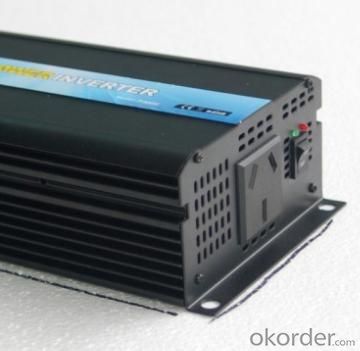
4, Detailed Specification
INPUT | |
Input voltage range | 185~265±5Vac |
OUTPUT | |
Output voltage range | 185~265±5Vac (AC mode) , 230Vac (DC mode) |
Output frequency (DC mode) | 50Hz (48~54Hz) or 60Hz(58~64Hz), same as AC(AC mode) 50Hz ±0.3Hz (DC mode) |
Wave form | Sine wave (DC Mode) |
Transfer time | 10ms. (Typical) |
BATTERY | |
Rated charging current (max.) | 45A |
Norminal DC input voltage | 12V |
Min. DC start voltage | 20V / 40V |
PHYSICAL | |
Unit dimension (mm) | 526*277*212 |
Master box dimension (mm) | 620*350*370 |
Net weight (1pc, kg) | 22.8 |
- Q: Can solar energy systems be used in powering agricultural processing facilities?
- Yes, solar energy systems can be used to power agricultural processing facilities. Solar energy systems, such as photovoltaic (PV) panels, can generate electricity from sunlight, which can then be used to power various electrical equipment and processes in agricultural processing facilities. This can include powering machinery used for cleaning, sorting, and packaging agricultural products, as well as running heating, ventilation, and air conditioning systems. Solar energy systems can also be integrated with battery storage solutions to provide a reliable and continuous power supply, even during periods of low sunlight or at night. Additionally, using solar energy to power agricultural processing facilities can help reduce reliance on fossil fuels, lower greenhouse gas emissions, and contribute to a more sustainable and environmentally friendly operation.
- Q: Can solar energy systems be used in areas with high levels of snowfall?
- Yes, solar energy systems can still be used in areas with high levels of snowfall. While snow can temporarily reduce the energy production of solar panels, they are designed to withstand heavy snow loads. Additionally, the angle and positioning of the panels can be adjusted to help snow slide off more easily. Regular maintenance and cleaning can also ensure optimal performance during snowy periods. Overall, with proper installation and management, solar energy systems can still be effective in areas with high snowfall.
- Q: Can solar energy systems be used for powering emergency backup systems?
- Yes, solar energy systems can be used for powering emergency backup systems. Solar panels can generate electricity during the day and store it in batteries, which can be used to provide power during emergency situations or when the main power grid is down. This makes solar energy a reliable and sustainable solution for backup power needs.
- Q: Can solar energy be used for large-scale power generation?
- Yes, solar energy can definitely be used for large-scale power generation. With advancements in technology and decreasing costs of solar panels, utility-scale solar power plants are being built around the world to generate electricity on a massive scale. These solar power plants can provide a significant amount of clean and renewable energy to meet the increasing power demands of cities and industries.
- Q: Are there any fire safety concerns associated with solar energy systems?
- Solar energy systems have been found to have fire safety concerns. Although they are generally considered safe and reliable, there have been instances where these systems have caused fires. One concern regarding fire safety is associated with the improper installation or maintenance of solar panels. If the panels are not installed correctly, there is a possibility of electrical faults or short circuits, which can lead to overheating and potentially result in fires. Similarly, if the system is not regularly inspected and maintained, it can increase the likelihood of electrical failures and subsequent fires. Another concern is related to the electrical wiring and connections of the solar energy system. Faulty wiring or loose connections can generate heat and potentially cause electrical fires. This is particularly relevant in older systems where the wiring may have deteriorated over time. Furthermore, firefighters may encounter additional challenges when dealing with buildings equipped with solar energy systems during a fire incident. The presence of live electricity generated by the panels can pose a risk to firefighters, making it more difficult to safely extinguish the fire. To address these fire safety concerns, it is crucial to have qualified professionals install solar energy systems in accordance with the necessary codes and regulations. Regular inspections and maintenance should also be carried out to promptly identify and resolve any potential issues. Additionally, proper training should be provided to firefighters on how to handle fires involving solar energy systems in order to minimize risks.
- Q: What is the role of tracking systems in solar energy systems?
- The role of tracking systems in solar energy systems is to maximize the efficiency and output of solar panels by allowing them to follow the sun's movement throughout the day. This ensures that the panels are constantly positioned at an optimal angle to receive the maximum amount of sunlight, resulting in increased energy production.
- Q: Can solar energy systems be used in conjunction with wind energy systems?
- Yes, solar energy systems can be used in conjunction with wind energy systems. This combination, often referred to as hybrid renewable energy systems, allows for more consistent and reliable power generation. By utilizing both solar and wind energy sources, the system can maximize energy production and provide a sustainable and efficient solution.
- Q: What is a photovoltaic solar energy system?
- A photovoltaic solar energy system is a renewable energy system that converts sunlight into electricity. It utilizes solar panels composed of multiple solar cells, which consist of semiconductors, usually silicon, that absorb photons from sunlight. When sunlight hits the solar panels, the photons transfer their energy to the electrons in the semiconductors, energizing them and generating an electric current. This current, initially in direct current (DC) form, is then converted into alternating current (AC) using an inverter, making it suitable for use in homes, businesses, or the electrical grid. Key components of a photovoltaic solar energy system include the solar panels, usually mounted on rooftops or open areas to maximize sunlight exposure. Various solar panel technologies exist, such as monocrystalline, polycrystalline, or thin-film, each with different efficiency levels and costs. To maximize efficiency, solar panels are often positioned at optimal angles and directions to capture as much sunlight as possible throughout the day. Additionally, inverters are employed to convert the generated DC electricity into AC electricity, which is the standard form used by most electrical appliances and devices. Photovoltaic solar energy systems offer numerous advantages. They contribute to environmental preservation by producing clean and renewable energy, reducing greenhouse gas emissions. They also have the potential to save costs by reducing or eliminating reliance on traditional energy sources. Furthermore, they require minimal maintenance and have a lifespan of around 25 to 30 years. In summary, a photovoltaic solar energy system effectively harnesses the sun's power to produce electricity, offering a sustainable and eco-friendly alternative to conventional energy sources.
- Q: What is the impact of roof age on the performance of solar panels?
- The impact of roof age on the performance of solar panels can be significant. A newer roof is generally more structurally sound and can better support the weight of solar panels. It is also less likely to have any existing issues such as leaks or damage that could affect the installation and performance of the panels. On the other hand, an older roof may have deteriorated over time, potentially leading to structural problems or leaks. This can pose challenges and additional costs during the installation process, as the roof may require repairs or reinforcement before the solar panels can be installed. Furthermore, an older roof may not be as energy-efficient as a newer one, which could affect the overall performance of the solar panels. The insulation and ventilation systems of an older roof may not be as effective, leading to increased heat transfer or poor air circulation, thereby reducing the efficiency of the panels. It is important to assess the condition of the roof before installing solar panels to ensure optimal performance and longevity. If the roof is in poor condition, it may be necessary to repair or replace it before proceeding with the installation. Overall, the age and condition of the roof can significantly impact the performance and efficiency of solar panels.
- Q: Can solar energy systems be used in areas with limited resources?
- Yes, solar energy systems can definitely be used in areas with limited resources. Solar energy is a sustainable and renewable source of power that can be harnessed even in remote or underdeveloped regions. These systems require minimal maintenance and can be easily installed, providing an affordable and reliable source of electricity. Solar energy can greatly benefit areas with limited resources by reducing their dependence on expensive and unreliable fossil fuels, improving access to electricity, and promoting economic and social development.
Send your message to us
Passive and Active Solar Energy Systems Solar MPPT 100/30 (30 A) Maximum Power Point Tracker
- Loading Port:
- China Main Port
- Payment Terms:
- TT or LC
- Min Order Qty:
- -
- Supply Capability:
- 10000 unit/month
OKorder Service Pledge
OKorder Financial Service
Similar products
Hot products
Hot Searches
Related keywords
